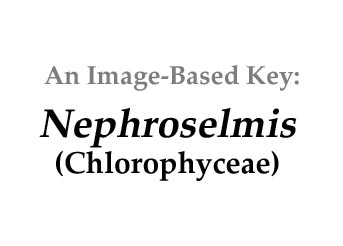|
Home / Chlorophyceae / Unicells / Flagellated / Nephroselmis |
||||
|
|
||||
|
Click on images for larger format |
||||
Name derivation: |
||||
|
Kidney-shaped noose?
|
||||
Classification: |
||||
Monomastix Scherffel 1912;
all 5 species descriptions are currently accepted taxonomically (Guiry and Guiry 2013.
Order Mamiellales; Family Monomastigaceae
Alternatively: Order Polyblepharidales; Family Pedinomonadaceae
|
||||
Morphology: |
||||
|
Green asymmetric unicell with one emergent flagellum from an anterior depression. Submicroscopic scales unlike any other chlorophycean cover the cell membrane. Single chloroplast, bilobed but essentially cup-shape, each lobe containing a pyrenoid. Posterior stima when present. Up to 7 trichocysts (ejectosomes) present in posterior end. Unequivocal molecular evidence links the green algal ancestor of the euglenoid chloroplasts to the Pyramimonadales, phylogenetic analyses of concatenated chloroplast genes and proteins elucidated the position of Monomastix and showed that the Mamiellales, a clade comprising Ostreococcus and Monomastix, are sister to the Pyramimonadales +Euglena clade (Turmel et al. 2008). |
||||
Similar genera: |
||||
Habitat: |
||||
|
Freshwater and marine. Free-living and symbiotic (endobiotic) in a heterotrophic protist, Hatena arenicola. Hatena (Japanese for ‘enigmatic’) is colorless and indivisible until it acquires the green PS free-living Nephroselmis through a ‘feeding tube’ that disappears after acquisition. The symbiont provides both food and vision. Hatena can now divide, without division of the symbiont, thus only one daughter cell of the host receives the Nephroselmis. The subsequent generation retains both the colorless predator and the PS reproductive form suggesting an incipient permanent secondary symbiosis (Okamoto and Inouye 2005). Question from Prof. Subhash Minocha (UNH): What’s the shelf life of the endobiont; i.e. how many divisions of the host cell can the captive Tetraselmis endure without dividing itself? |
||||
References: |
||||
|
Guiry, M.D. and
G.M. Guiry 2013. AlgaeBase.
World-wide electronic publication, National University of Ireland, Galway.
http://www.algaebase.org; searched on 16 April 2013. Okamoto, N., and I. Inouye 2005. A secondary symbiosis in progress? Science 310(5746):287. Scherffel, A. 1912.
Zwei neue, trichocystenartige Bildungen führende Flagellaten. Archiv für
Protistenkunde 27: 94-128. Turmel, M., M-C Gagnon, C.J.
O’Kelly, C. Otis and C. Lemieux 2008. The chloroplast genomes of the green algae Pyramimimonas, Monomastix, and
Pycnococcus
shed new light on the evolutionary history of Prasinophytes
and the origin of the secondary chloroplasts of Euglenids. Molecular Biology and Evolution 26(3):631-648.
|
||||




